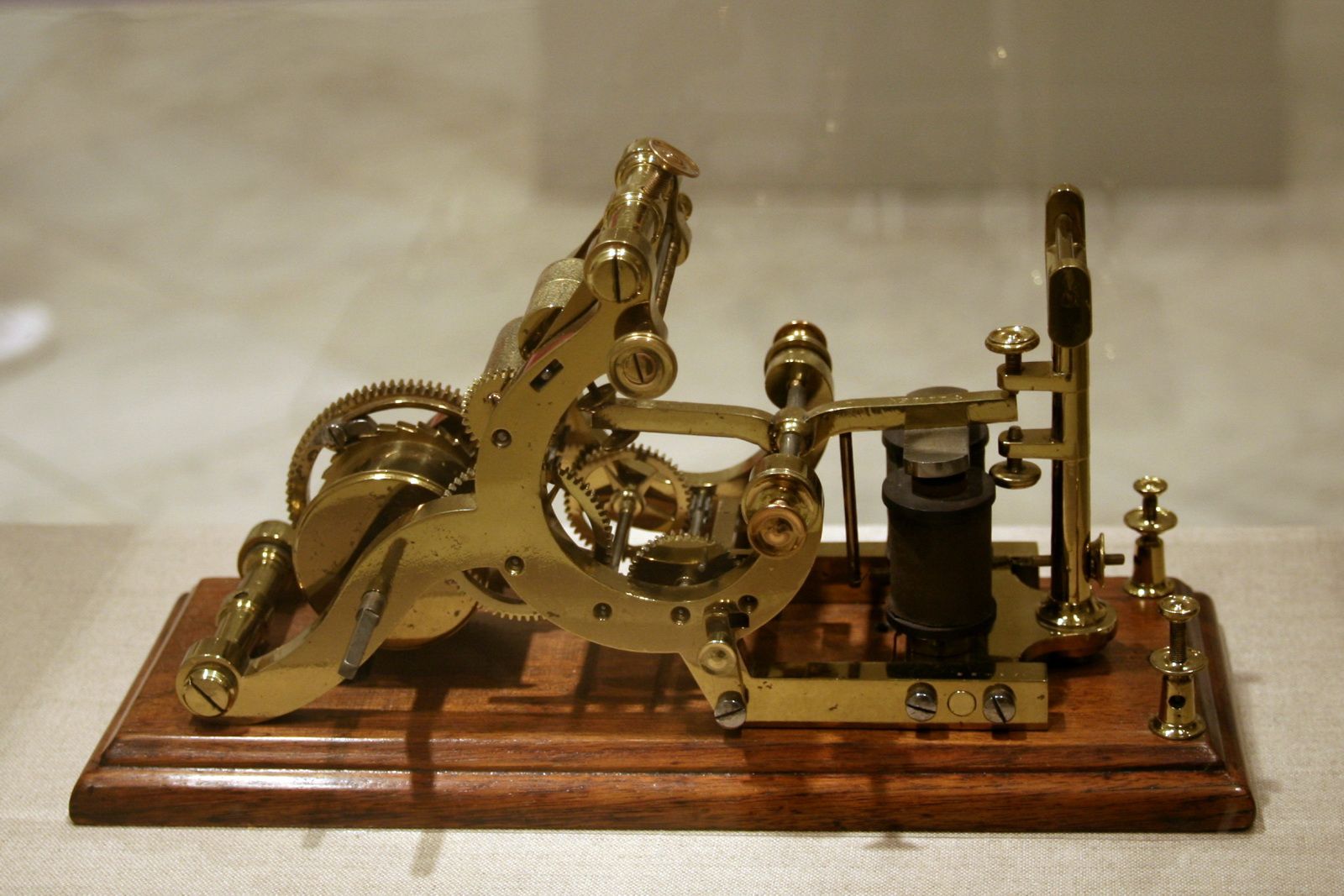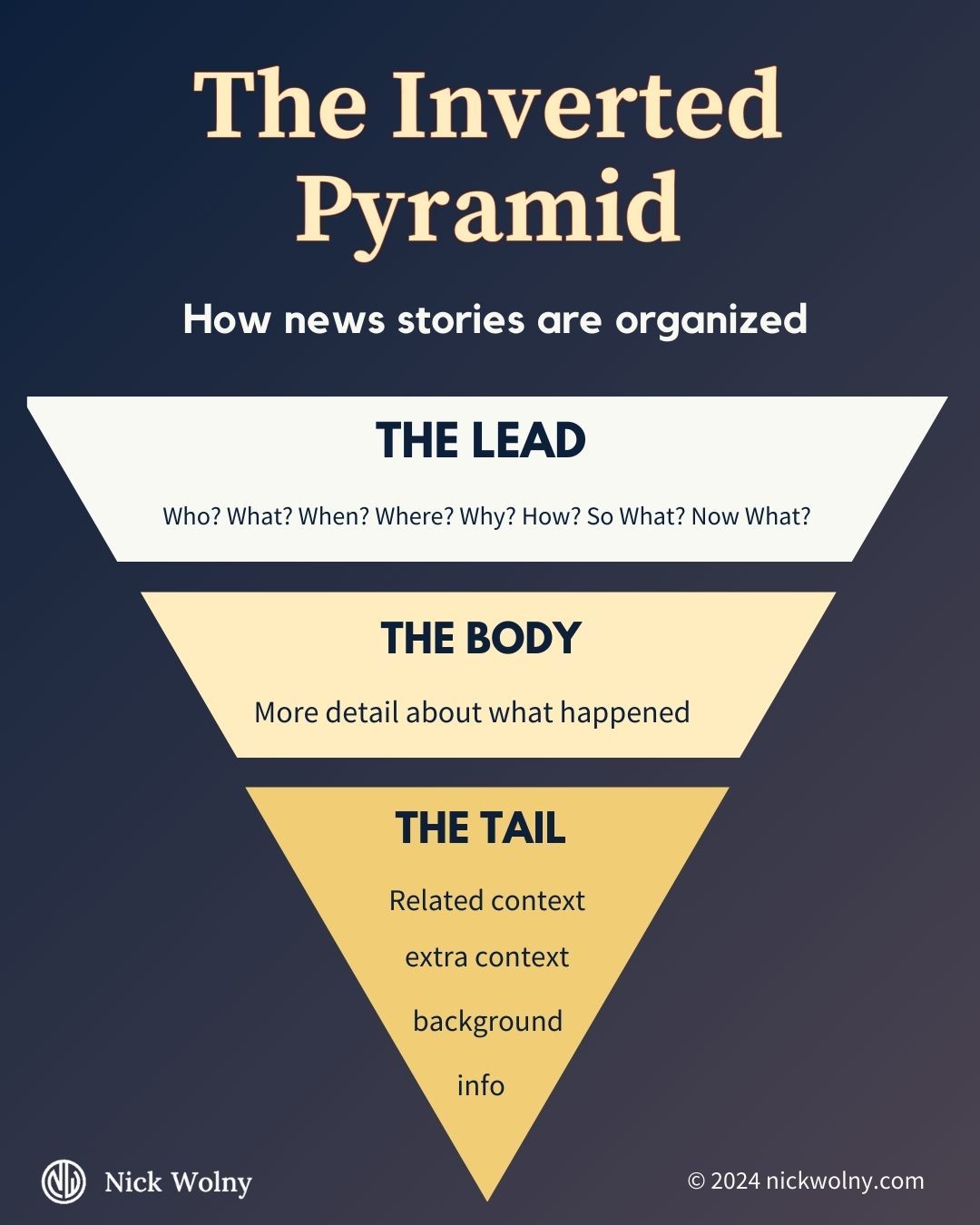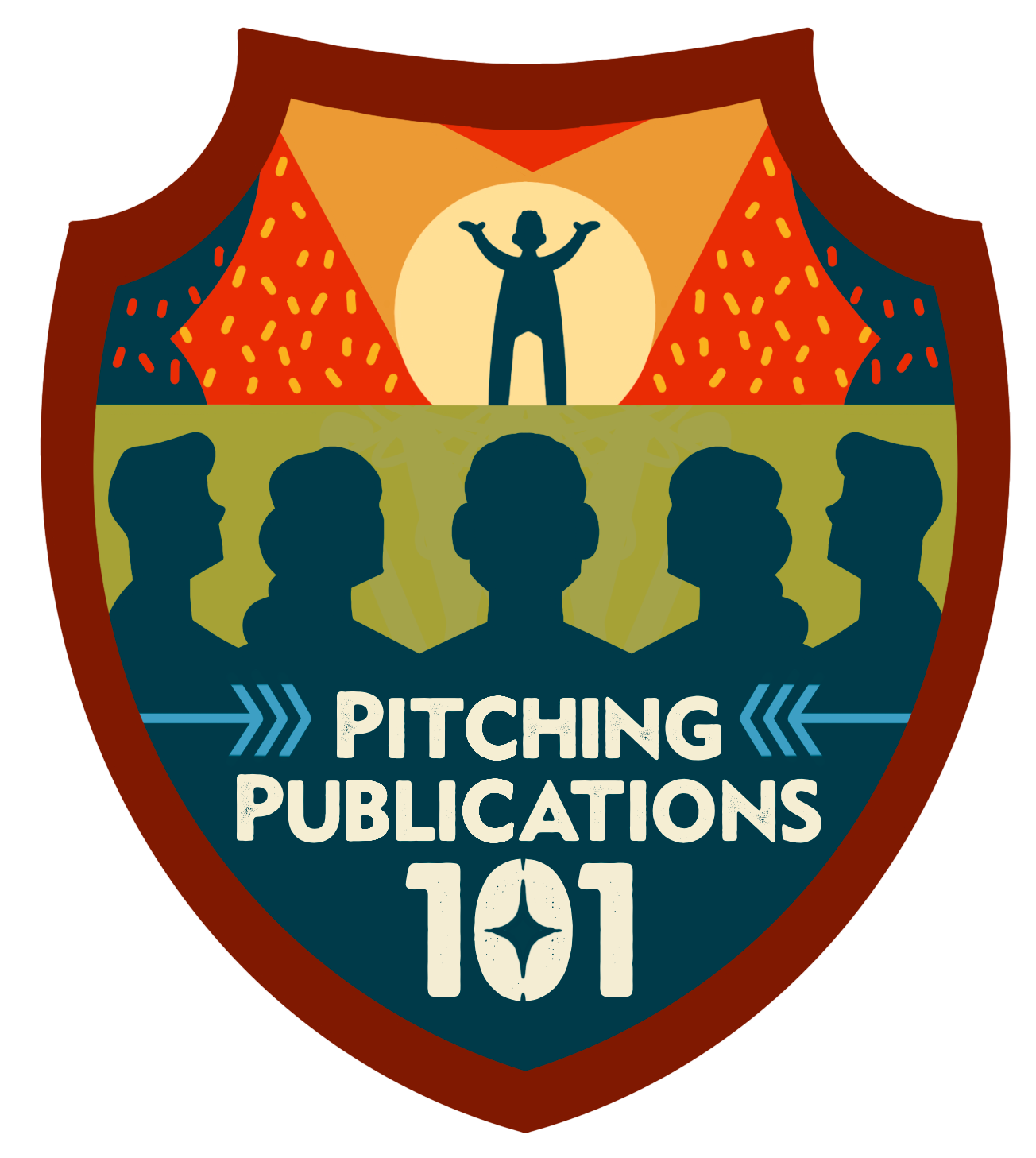The inverted pyramid is a story format that summarizes information in order to grab and maintain a reader’s attention.
When you read the news, the most important details of a story are often communicated first. As you read on, these same details are reintroduced, but with increasing amounts of detail -- almost like adding layers of paint to a wall to add color and make it more vibrant. 💅🏼
These news stories are examples of inverted pyramid journalism, a writing style that prioritizes clarity to inform the reader as succinctly as possible. The inverted pyramid style is popular in genres of nonfiction that want to inform rather than influence the reader.
Learning how to write in alignment with inverted pyramid structure is a common first-year exercise for journalism and communication students. This article will cover the history of the format and its components, along with examples of inverted pyramid writing from actual news publications.
Key Takeaways
- In an inverted pyramid, the most important information of the story is summarized first in a section known as a lead.
- Then, in subsequent sections known as the body and the tail, additional details and context are provided to give readers a richer understanding of a topic.
- When you use the inverted pyramid effectively, readers are engaged and feel informed, even if they have short attention spans.
Origin of the Inverted Pyramid
The inverted pyramid style came about as a result of Samuel Morse inventing the telegraph in 1845. Since operating a telegraph meant dictating a story using morse code, it was important to communicate the most important information and attention grabbing elements of a story first to cut down on dictation time.
The key points were communicated in descending order by diminishing importance, with the least important information coming last. This approach minimized the chance that a disconnection would prevent news from being reported.

The automatic telegraph receiver was patented by Samuel Morse in 1837. Source: Wikimedia commons

A plaque in Washington, DC commemorating Samuel Morse's first telegraph. Source: Wikimedia Commons
You don’t have to be creative or at the level of professional media writers when using the inverted pyramid format. The value you provide comes from your ability to organize essential facts, rather than the style or entertainment value of the story.
Inverted pyramid writing makes you land the main point in the first sentence or lead paragraph, and it will help you structure content in your other journalistic writing efforts.
The Inverted Pyramid Structure, Explained
As you might expect, the inverted pyramid method is illustrated as an upside-down pyramid with three distinct sections: the lead, the body and the tail.

The Lead
The lead — sometimes spelled “lede” — contains the most important information in your article.
A lead has the essentials, the important details, communicated in the first words or first sentences of the article to land a single point. In inverted pyramid journalism, you are front loading details into the lead paragraph or even the first sentence.
Related: How to Write a Good Lead: 9 Winning Formulas
In a lead, we want the main points explained in short paragraphs to keep the story moving. Remember, you'll return back to these main points and add more supplemental detail in later parts of your article.
Many consider the lead to be the most challenging section of an article to write, because it forces you to be clear about your main point or central idea in as few words as possible. Readers love a good lead, and search engines do too.
Tip:Learning how to write a news lead will strengthen your ability to deliver clean, crisp messaging.
What Should Go Into a Lead?
A lead should answer the “5 W’s and 1 H”:
- Who: who is involved in the story? Name names.
- What: the point of the story.
- Where: where the story is taking place. Give us proximity.
- When: help us get oriented by providing a timeline.
- Why: what’s the motivation of those involved in the story? This could include the characters in the story, the reader, or both.
- How: how was or should the motivation be acted on?
Some other details to consider in a lead can include:
- So what? Tell us why we should care as readers.
- What’s next? Give us solutions or go-forward action steps. Journalism that aspires to help readers is called service journalism.

Limited-Time Offer: ‘Pitching Publications 101’ Workshop
Get the ‘Pitching Publications 101’ Workshop and two other resources as part of the Camp Wordsmith® Sneak Peek Bundle, a small-bite preview of my company's flagship publishing program. Offer expires one hour from reveal.
The Body
The body of your story gives additional supporting details about your story, but if the reader were to not have these details, they would still have a grasp of what the story is about.
The body might take place in the opening section of your article, before the first subheadline, but after the initial lead sentence or lead paragraphs. It ultimately depends on the story structure and your writing style.
A body can also be a great place to introduce other multimedia. If you have photos, videos, or graphics to embed into your story that gives it more detail, the body is the best place to introduce these components.
The Tail
Once we reach the tail, the article continues on until it reaches its conclusion. The tail expands on the details or motivations explained in the initial lead with supporting details.
The tail can be one or several sections in length — again, it depends on story structure — and focuses on giving the reader the supporting details needed for them to comprehend a topic, feel inspired, and/or start taking action.
Related: Writing on Medium in 2023: The Ultimate Guide
Assume that readers will skim your article at first. By providing the most essential information in the beginning of the article, you’ll set them up to better understand what they’re skimming. They may reach the conclusion of your article and then decide to go back to the top for a deeper read.
Inverted Pyramid Examples
Let's first look at an example of a lead.
Our example is a Business Highlights story from the Associated Press (AP), a not-for-profit global news organization that also has a respected news stylebook. I recommend checking out and bookmarking the Associated Press’ Business Highlights page to see great examples of news leads. AP is famously neutral and factual in its news writing.
Here is an example of a news lead from AP. This paragraph is the entire story — notice how succinct it is.
IRS raises contribution limits for retirement savings plans
WASHINGTON (AP) — Americans will be allowed to contribute more of their money to 401(k) and similar retirement saving plans next year. The IRS said Friday that savers with 401(K) and similar plans will be able to contribute up to $22,500 next year. That’s up from $20,500 this year. People aged 50 and over, which have the option to make additional “catch-up” contributions to 401(k) and similar plans, will be able to contribute up to $30,000 in 2023. The IRS also raised the annual contribution limits on individual retirement arrangements, or IRAs, by $500 to $6,500. The changes make it easier for retirement savers to set aside more of their income toward building their nest egg.
Study how the reporter has arranged the who, what, where, when, why and how of the story. By using short, crisp sentences, the journalist helps readers understand the events of the day.
Related: How to Pitch an Article: 70+ Outlet How-Tos
Now let’s look at an example of how a news outlet publishes a story in the inverted pyramid format. This is a news story that previously ran in the Columbia Missourian. It's eight paragraphs in length; see if you can spot where the lead, body and tail transitions are in this story.
Man Arrested in Attack, Charged with Child Endangerment
By Elizabeth Phillips
Police arrested a Columbia man in connection with an attack on his girlfriend Thursday night.
Darrell Vanness Johnson, 37, was arrested on suspicion of second-degree domestic assault, unlawful use of a weapon, felony possession of a controlled substance, misdemeanor possession of a controlled substance and endangering the welfare of a child at about 9 p.m. Thursday in the 1500 block of Greensboro Drive.
Johnson and his girlfriend began arguing over drugs Thursday evening, Columbia Police Sgt. Ken Hammond said. Johnson choked her and held a revolver to her head before she was able to escape and call 911 from a neighbor’s house, Hammond said. Three children, two 9-year olds and a 4-year-old, were in the home during the attack, Hammond said.
When Columbia police arrived, Johnson was driving away from the Greensboro Drive home with the three children in the car, Hammond said. When police arrested Johnson, they found marijuana and cocaine, Hammond said.
The victim was taken to an area hospital by ambulance for treatment of bruises and scratches to the hands, neck and back, Hammond said. Her injuries were not life threatening.
According to MissouriCase.net, Johnson has pleaded guilty to third-degree domestic assault three times in the past four years in Boone County Circuit Court, serving close to seven months in jail for those charges. He has also pleaded guilty to theft, first-degree trespass and second degree property damage in Boone County Circuit Court, serving 75 days in Boone County Jail for the theft charge and receiving two years of unsupervised probation for the trespass and property damage charges.
Johnson violated his probation on the trespass and property damage charges and was scheduled to appear in Boone County Circuit Court for a probation violation hearing in December. He was charged with theft last October in Boone County Circuit Court.
He faces up to 40 years in prison and up to a year in jail in connection with the attack.
(SOURCE: The Missouri Group; Brooks, Brian S.; Moen, Daryl R.; Kennedy, George; Ranly, Don. Telling the Story: The Convergence of Print, Broadcast and Online Media (p. 123). Bedford/St. Martin's. Kindle Edition.)
The first two paragraphs comprise the lead. Notice how each sentence gets its own paragraph; short paragraphs were and still are common in news writing because of the narrow margins of newspapers.
Together, these first two paragraphs communicate the absolute essentials of the story. You as a reader know what happened in just a few seconds. You could stop reading here and still be reasonably informed.
Police arrested a Columbia man in connection with an attack on his girlfriend Thursday night.
Darrell Vanness Johnson, 37, was arrested on suspicion of second-degree domestic assault, unlawful use of a weapon, felony possession of a controlled substance, misdemeanor possession of a controlled substance and endangering the welfare of a child at about 9 p.m. Thursday in the 1500 block of Greensboro Drive.
The next three paragraphs are the body. Notice that these details are still about the incident at hand. They provide the chronology of the incident in more detail, including timestamps and details from the police report.
We're still at the scene of the crime, though, and that's one way we could interpret the transition point between the body and the tail. We now have a much clearer timeline of the events of the evening.
Johnson and his girlfriend began arguing over drugs Thursday evening, Columbia Police Sgt. Ken Hammond said. Johnson choked her and held a revolver to her head before she was able to escape and call 911 from a neighbor’s house, Hammond said. Three children, two 9-year olds and a 4-year-old, were in the home during the attack, Hammond said.
When Columbia police arrived, Johnson was driving away from the Greensboro Drive home with the three children in the car, Hammond said. When police arrested Johnson, they found marijuana and cocaine, Hammond said.
The victim was taken to an area hospital by ambulance for treatment of bruises and scratches to the hands, neck and back, Hammond said. Her injuries were not life threatening.
The final three paragraphs are the tail. These paragraphs provide additional reading, more characterization and depth to the story. Notice how the tail is more about the past and future than the present. We get detail on Johnson's record, as well as what his consequences may be.
.
According to MissouriCase.net, Johnson has pleaded guilty to third-degree domestic assault three times in the past four years in Boone County Circuit Court, serving close to seven months in jail for those charges. He has also pleaded guilty to theft, first-degree trespass and second degree property damage in Boone County Circuit Court, serving 75 days in Boone County Jail for the theft charge and receiving two years of unsupervised probation for the trespass and property damage charges.
Johnson violated his probation on the trespass and property damage charges and was scheduled to appear in Boone County Circuit Court for a probation violation hearing in December. He was charged with theft last October in Boone County Circuit Court.
He faces up to 40 years in prison and up to a year in jail in connection with the attack.
It's not unusual for the tail to be the majority of the story. Remember that the lead is about establishing a succinct summary or context, and that the job of the body is to recap the lead in more detail.

Limited-Time Offer: ‘Pitching Publications 101’ Workshop
Get the ‘Pitching Publications 101’ Workshop and two other resources as part of the Camp Wordsmith® Sneak Peek Bundle, a small-bite preview of my company's flagship publishing program. Offer expires one hour from reveal.
Frequently Asked Questions
Who Uses the Inverted Pyramid Style?
The inverted pyramid is commonly used in journalism and news writing to communicate the main point up front.
What Are the Advantages of the Inverted Pyramid?
It prioritizes key details first, is easy to organize, helps readers skim efficiently, and is easy to edit later.
Should I Always Use the Inverted Pyramid?
No, it works well for some topics but narrative or chronological structures may be better for other stories.
What Are the Different Types of Leads?
There are many types of leads. You can choose from a news lead, summary lead, anecdotal lead, and more.
Make Your Stories Easier to Read
The inverted pyramid structure is great for essay writing, news writing, or just getting your thoughts organized into a published article.
Practice the inverted pyramid style in article or blog post and you’ll see your overall writing improve. ◆
Thanks For Reading 🙏🏼
Keep up the momentum with one or more of these next steps:
💬 Leave a comment below. Let me know a takeaway or thought you had from this post.
📣 Share this post with your network or a friend. Sharing helps spread the word, and posts are formatted to be both easy to read and easy to curate, with nice image previews. You'll look savvy and informed.
📲 Connect on another platform. I’m currently publishing in these places. If you are too, say hello:
- Medium: Articles and thought essays.
- Threads: Casual, Twitter-esque commentary.
- Instagram: Media appearances, and some occasional IRL posts to Stories.
- TikTok: Occasional video scraps from reporting and life.
- LinkedIn: Buttoned-up posts.
📬 Sign up for my free email list. Financialicious is a free newsletter about online business and finance from a gay male editor’s perspective. Learn more and browse past editions here.
🏕 Up your writing game. Camp Wordsmith® is a content marketing strategy program for small business owners, service providers, and online professionals. Learn more here.
📊 Hire me for consulting. I provide 1-on-1 consultations through my company, Hefty Media Group. We're a certified diversity supplier with the National Gay & Lesbian Chamber of Commerce. Learn more here.

Limited-Time Offer: ‘Pitching Publications 101’ Workshop
Get the ‘Pitching Publications 101’ Workshop and two other resources as part of the Camp Wordsmith® Sneak Peek Bundle, a small-bite preview of my company's flagship publishing program. Offer expires one hour from reveal.


